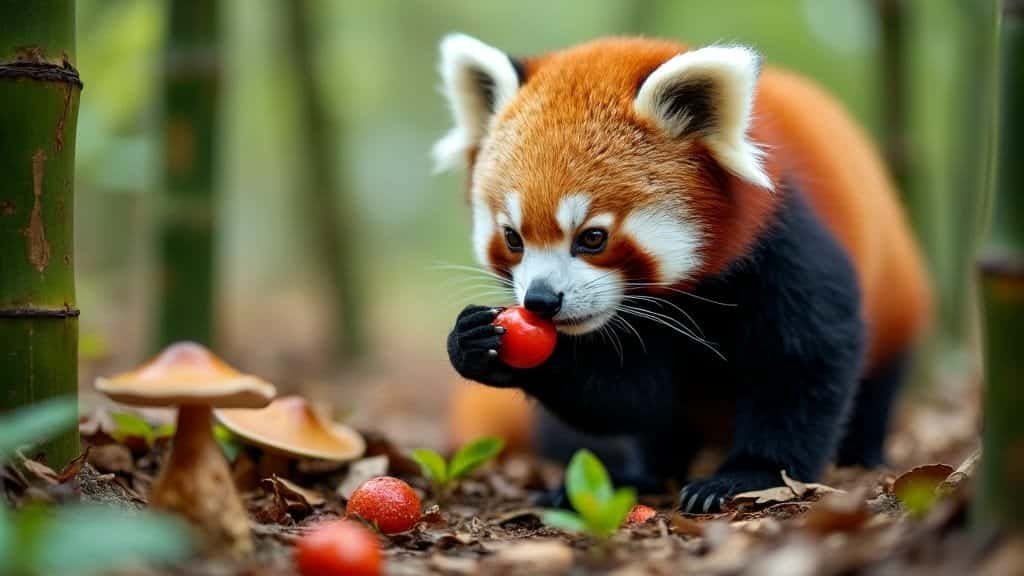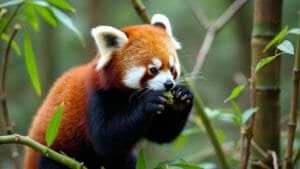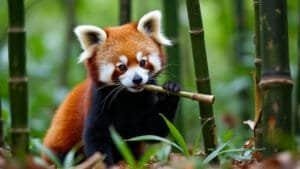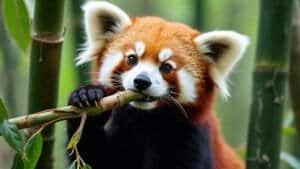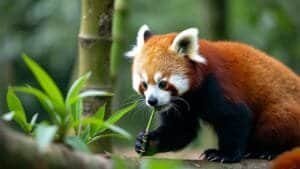While bamboo makes up the majority of a red panda’s diet, these animals also consume a variety of other foods to supplement their nutritional needs. Unlike giant pandas, which rely almost exclusively on bamboo, red pandas eat fruits, berries, flowers, roots, acorns, and even small amounts of protein-rich foods such as insects, bird eggs, and small mammals. This dietary flexibility allows them to adapt to seasonal changes in food availability, ensuring they can survive even when bamboo is less nutritious
In the wild, red pandas select foods based on nutrient content and availability. During warmer months, they consume fruits and berries for added energy, while in winter, they may eat roots, bark, and lichen when other foods are scarce. Though they belong to the order Carnivora, red pandas rarely hunt but will opportunistically consume small prey when necessary. In captivity, their diet is more controlled, often including leaf-eater biscuits, fruits, and mealworms to provide balanced nutrition
This article explores what foods red pandas eat besides bamboo, including their seasonal dietary changes, the role of fruits and protein sources in their nutrition, and the differences between their diet in the wild versus captivity. We will also examine how their dietary needs impact conservation efforts, as habitat loss threatens their primary food sources
The Variety in a Red Panda’s Diet
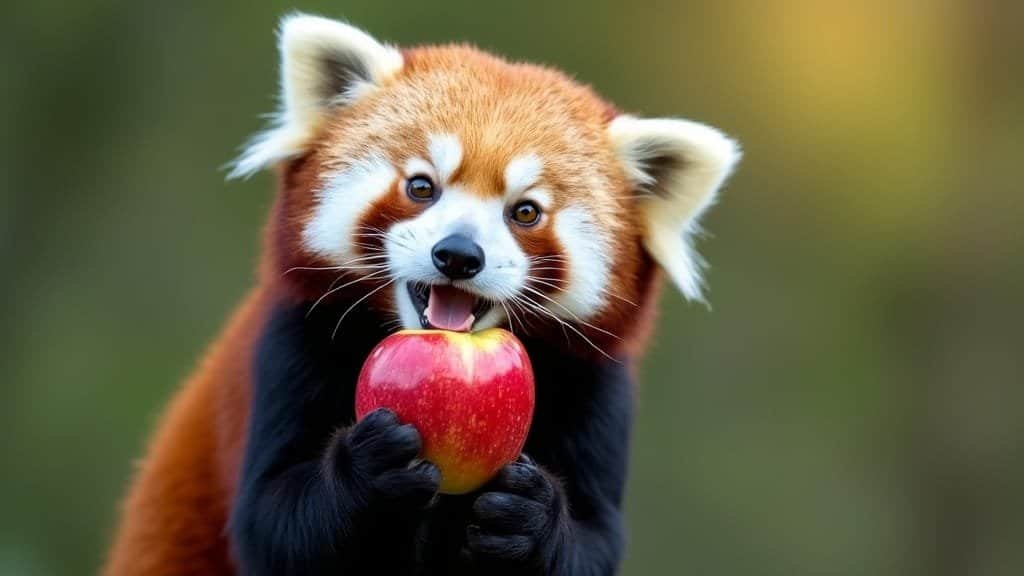
While red pandas are best known for their dependence on bamboo, their diet includes a variety of other foods that help meet their nutritional needs. Seasonal shifts in food availability influence what red pandas eat, leading them to consume fruits, insects, and other plant materials when possible. These foods supplement their low-calorie bamboo diet, providing additional vitamins, minerals, and proteins that bamboo lacks
What Types of Fruits Do Red Pandas Eat?
Fruits are an important part of a red panda’s diet, especially during the warmer months when they are most abundant. In the wild, red pandas consume wild figs, raspberries, mulberries, apples, and various berries. These fruits provide natural sugars that boost energy levels, as well as essential vitamins that help support their overall health. A study by Wei et al. (Journal of Mammalogy, 2014) found that red pandas increase their fruit intake in late summer and early fall, likely as a way to store extra energy before winter, when food is less nutritious
In captivity, red pandas are often given apples, grapes, and bananas, which help ensure they receive enough vitamins and minerals. While fruits are a small part of their overall diet, they play a key role in supplementing their low-protein bamboo intake, making them a valuable seasonal food source
Do Red Pandas Eat Insects or Small Animals?
Despite their classification as carnivores, red pandas rarely consume meat. However, they opportunistically eat insects, bird eggs, and small vertebrates when available. Insects such as caterpillars, grubs, and beetles provide additional protein and fats, which are critical nutrients that bamboo lacks. Unlike actively hunting predators, red pandas do not chase or stalk prey but will consume small animals if they encounter them while foraging
Occasionally, red pandas may eat bird eggs or even small lizards and rodents, though this is rare and not a significant part of their diet. The Smithsonian National Zoo notes that captive red pandas are sometimes fed mealworms or other protein sources, highlighting their ability to digest non-plant foods when necessary. However, their carnivorous ancestry is mostly reflected in their digestive structure rather than their dietary habits
How Do Fruits Supplement a Red Panda’s Diet?
Because bamboo provides very little digestible energy, red pandas rely on fruits and other supplemental foods to balance their nutrition. Fruits contain natural sugars, which give red pandas quick bursts of energy, allowing them to maintain body weight and activity levels throughout the year. The vitamins and minerals found in fruits also help support immune function and metabolism, making them an important seasonal addition to their diet
In the wild, fruit consumption varies based on geographic location and seasonal availability. Red pandas living in lower-altitude forests tend to eat more fruit because more plant diversity exists in these regions. Those in higher-altitude habitats rely more heavily on bamboo but will still consume fruits when they are available
For more insights into what red pandas eat beyond bamboo, visit the World Wildlife Fund’s article on red panda diets
Plant-Based Foods Beyond Bamboo
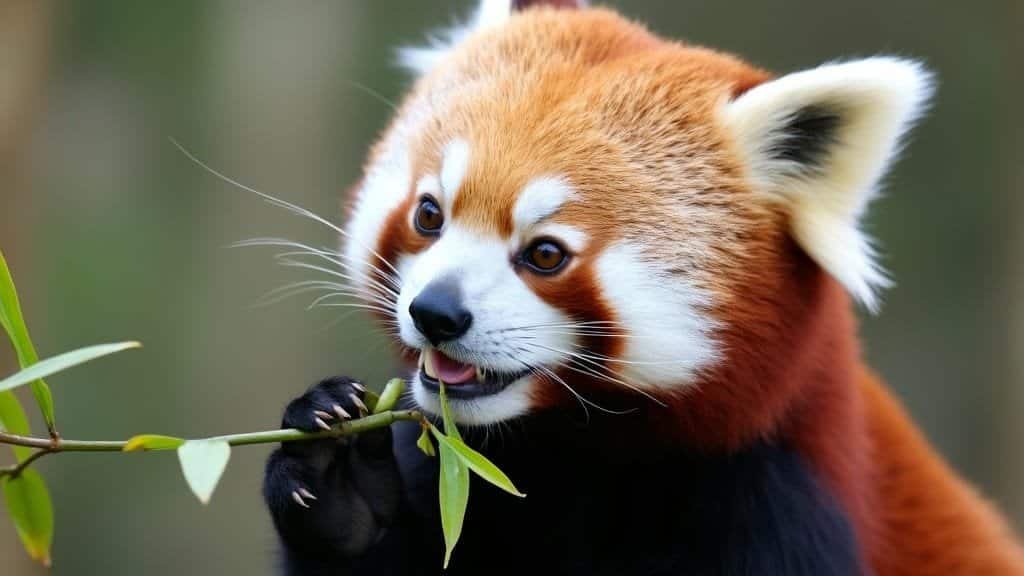
While bamboo is the primary component of a red panda’s diet, they also consume various other plant materials, particularly when bamboo is less nutritious or scarce. These additional plant-based foods provide fibers, minerals, and hydration, helping red pandas maintain their health in different environmental conditions
What Role Do Flowers and Leaves Play in a Red Panda’s Nutrition?
Red pandas often eat flowers and tender leaves from various plant species, particularly in spring and summer when these foods are more abundant. Flowers provide nectar and carbohydrates, which offer additional energy, while young leaves contain moderate amounts of protein and essential nutrients that help supplement their bamboo-based diet
Flowers and leaves are more commonly consumed by red pandas living in lower-altitude forests, where plant diversity is higher. In contrast, those in higher-altitude regions rely almost entirely on bamboo due to the limited availability of other vegetation. However, regardless of their habitat, red pandas are highly selective eaters and will always choose the most nutrient-rich plant parts available
Why Do Red Pandas Eat Non-Bamboo Plant Materials Like Moss and Bark?
In winter, when bamboo loses much of its nutritional value, red pandas may resort to eating moss, lichen, tree bark, and roots. These plant materials provide little direct nutritional benefit but may help with digestion by adding fiber to their diet. Some researchers suggest that these foods serve as a last-resort option when other resources are scarce
Bark and moss consumption is most common in high-altitude red panda populations, where food shortages are more severe during winter. While these materials do not contribute significantly to their daily caloric intake, they allow red pandas to survive in harsh conditions when better food sources are unavailable
Do Red Pandas Eat Different Foods Depending on the Season?
Red pandas’ diet changes throughout the year based on food availability and nutritional needs. In spring and summer, they consume bamboo shoots and young leaves, which are higher in protein and water content. During late summer and early fall, red pandas increase their fruit intake, likely to store extra energy for winter. In winter, when bamboo is less nutritious, they rely more on mature leaves, bark, moss, and other plant materials
Their seasonal diet shift highlights their ability to adapt to environmental changes. While bamboo remains their primary food source year-round, these dietary variations help red pandas maintain a balanced nutrient intake, ensuring their survival even in challenging winter conditions
For more information on how red pandas adapt their diet seasonally, visit the Smithsonian National Zoo’s article on red pandas
Red Panda Diet in Captivity vs. the Wild
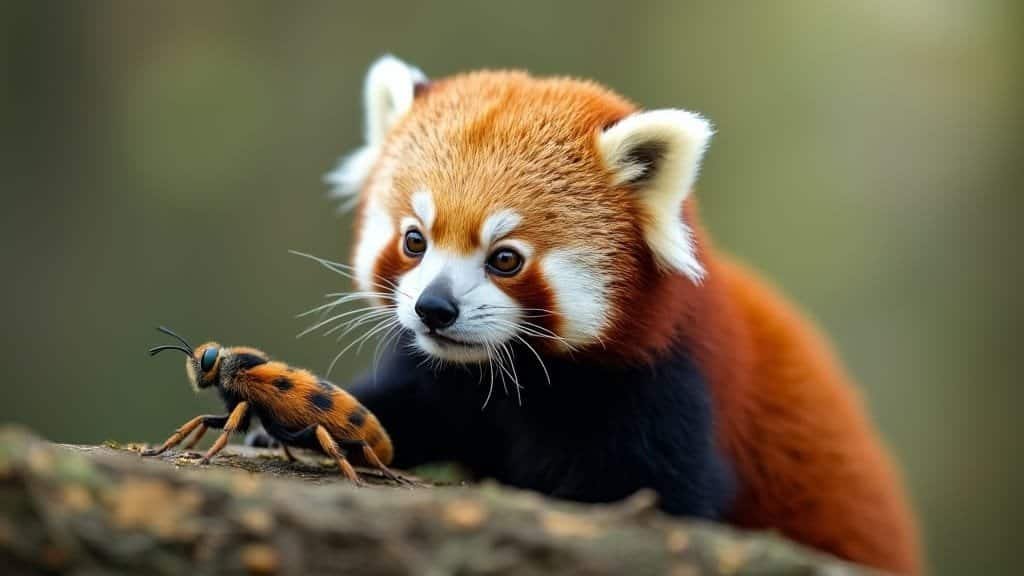
The diet of red pandas in captivity differs significantly from that of their wild counterparts. While wild red pandas rely on seasonal food availability, captive red pandas are provided with a controlled diet to ensure proper nutrition. This contrast highlights the challenges of nutrient absorption, food selection, and conservation efforts in maintaining red panda populations
What Do Red Pandas Eat in Captivity Besides Bamboo?
In zoos and wildlife conservation centers, red pandas are fed a carefully managed diet designed to replicate their natural eating habits while supplementing missing nutrients. Bamboo remains the staple food, but captive red pandas are also given fruits, leaf-eater biscuits, vegetables, and occasional protein sources
Fruits such as apples, bananas, grapes, and pears are commonly included in their diet, as they provide sugars, vitamins, and hydration. Leaf-eater biscuits, which are nutrient-dense and high in fiber, help compensate for the low protein and mineral content of bamboo. Additionally, some zoos offer mealworms, eggs, or other protein-rich foods to ensure a balanced diet
This controlled feeding strategy prevents malnutrition and energy deficiencies, which are common challenges for wild red pandas that depend solely on bamboo. Captive red pandas also tend to be heavier and live longer than their wild counterparts due to more consistent food intake and the absence of predators
How Does Food Availability Affect a Red Panda’s Diet in the Wild?
In the wild, red pandas’ diet is directly influenced by seasonal food availability and habitat conditions. Bamboo remains their primary food source, but the quality and quantity of bamboo fluctuate throughout the year. During warm months, they consume more bamboo shoots, fruits, and tender leaves, while in winter, they are forced to eat mature leaves, bark, moss, and roots due to food shortages
Climate change and habitat destruction have further impacted food availability. When bamboo forests are destroyed, red pandas are forced to travel farther in search of food, increasing their vulnerability to predators, human disturbances, and malnutrition. Habitat fragmentation also reduces their access to alternative food sources, limiting their ability to supplement their diet with fruits and insects
Conservation efforts aim to preserve bamboo forests and restore natural feeding areas to ensure wild red pandas have sufficient food resources throughout the year. Organizations working in red panda conservation monitor bamboo growth patterns and plant new bamboo forests to support wild populations
How Does a Red Panda’s Diet Compare to Other Bamboo-Eating Animals?
Although red pandas are best known for their bamboo diet, they are not the only animals that rely on this plant as a food source. Giant pandas, bamboo lemurs, and bamboo rats are other species that consume bamboo, but their feeding strategies and digestive adaptations differ significantly
Giant pandas, for example, consume between 26 and 84 pounds (12 to 38 kg) of bamboo daily, far more than red pandas, which eat 2.2 to 4.4 pounds (1 to 2 kg) per day. This difference is due to their larger body size and higher energy requirements. Giant pandas also have a longer digestive tract and gut bacteria specialized in breaking down cellulose, allowing them to extract more nutrients from bamboo than red pandas
Bamboo lemurs, found in Madagascar, also feed primarily on bamboo but have developed a unique tolerance to cyanide, which is present in some bamboo species. Red pandas do not have this adaptation and must be selective in choosing specific bamboo species to avoid toxicity
These comparisons highlight how red pandas have adapted to a bamboo-heavy diet despite lacking specialized digestive traits. Unlike other bamboo eaters, they rely on supplementary foods such as fruits, flowers, and insects to compensate for their digestive inefficiency, making their diet more varied than that of some other bamboo-dependent species
For more insights on how a red panda’s diet compares to other bamboo-eating animals, visit the World Atlas article on red panda diets
